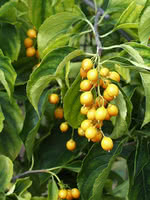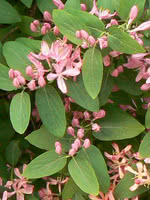Mon-Fri 9am - 5pm Mountain time
American Bittersweet vs Twining Honeysuckle
Celastrus scandens
Lonicera dioica
NOT AVAILABLE THIS SEASON - MIGHT RETURN
CUSTOM GROW
American Bittersweet is a deciduous, woody, perennial vine with striking orange to yellow berries that persist into winter. Indigenous to North America, this vine has become so rare it is now considered a protected species.
Excellent for naturalization projects, American Bittersweet attracts birds and other wildlife. Please keep in mind that the plant is toxic to humans and should not be ingested. To ensure the attractive berries are produced, cross-pollination between a male and female plant must occur.
Twining Honeysuckle is a vine native to the forests of Canada and the United States.
It can often be found winding up the bark of large trees or spreading out as a ground cover where no supports are present. You will love the attractive, yellow-orange flowers with pink centers which turn into red, inedible berries.
Consider Twining Honeysuckle when trying to achieve a natural, spreading, unkempt look for your garden.
American Bittersweet Quick Facts
Twining Honeysuckle Quick Facts
Toxicity: All parts of plant are toxic to humans

